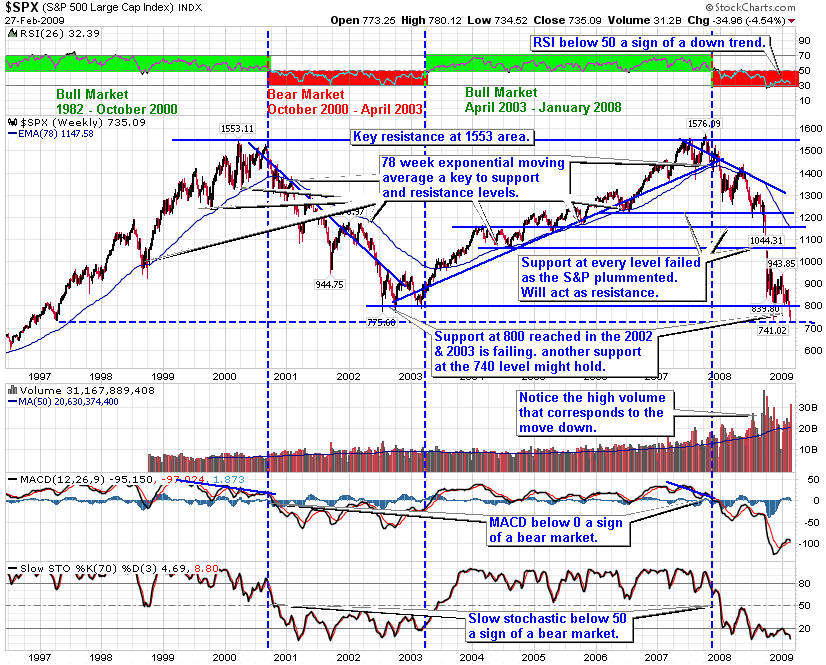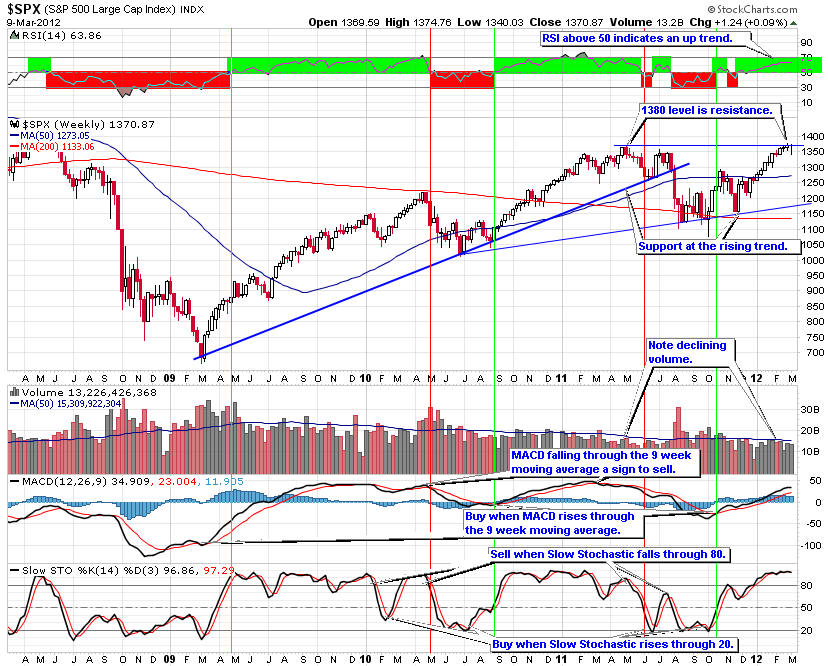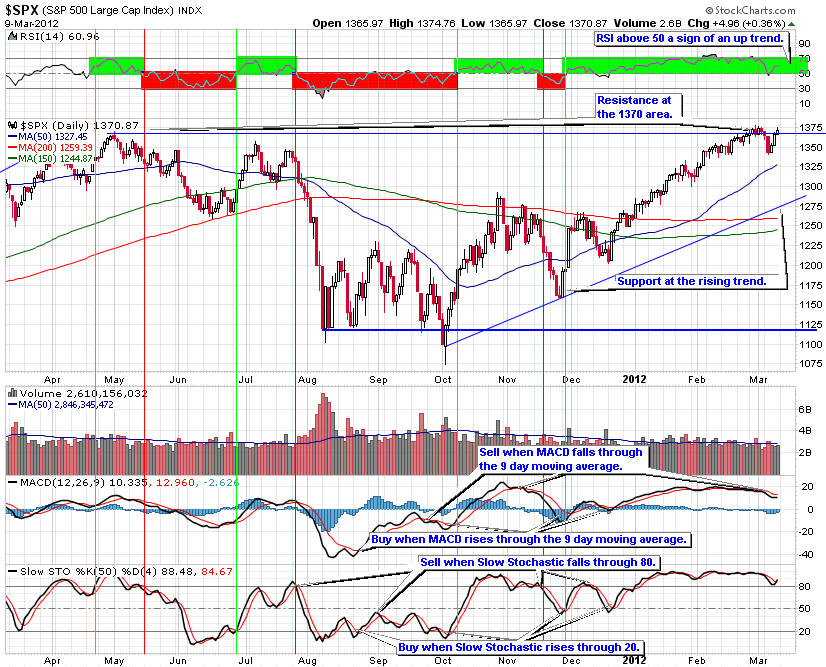

This is a free monthly newsletter on stock market trends to help you to learn to invest. Following the trend is a proven way to beat the market and grow your stock portfolio. Basic technical analysis provides the tools to identify and follow the market trends using the S&P 500.
To identify the stock market trend, it is best to begin with the big picture in mind and then work our way down to weekly and then daily views of the charts. You will notice that the chart and the value of the indicators change as we move from a monthly to a weekly and then a daily chart. This is a normal part of the technical analysis.
Starting with the long term view of the S&P 500, you can see peak resistance was reached at the same level at the end of the bull market of 2000 and the bull market of 2008. The S&P 500 has fallen to the lows of 2002 - 2003, the last bear market. This does not mean the current bear market is over. Rather we might see a rally for several weeks to months before retesting of the lows of this bear market. Or we could fall through this important support level to new lows.
The Relative Strength Index (RSI) is a good indicator of the cyclical bull and bear markets. In addition, the 78 week Exponential Moving Average (EMA) acts as support in a bull market and resistance in a bear market.
In January 2008, we fell into a bear market as the RSI dropped below 50. The index fell through the rising trend line and the 78 week exponential moving average and MACD crossed below zero. This is consistent with the fundamentals of a weakening economy, and a recession. In a bear market, the general trend is down. Investors should have down side protection in place and use the short Exchange Traded Funds (ETFs) to capture additional profit.
In the big picture, we remain in a bear market with key resistance at the 78 week exponential moving average and the bear market down trend.

The three year weekly S&P 500 chart shows more closely the transition from a bull to a bear market. So far the descending trend line and the 50 week moving average are the primary resistance for view this view of the bear market.
Most recently, the index formed a descending triangle pattern, a bearish formation. If the index breaks down through support, the market is likely to fall further. On the other hand, if it breaks out through the descending trend line, we could see up trend in the stock market. The 800 level is an important support level to monitor.
RSI below 50 indicates a down trend. MACD turned up through the nine week moving average, a buy sign. Slow Stochastic rose through 20, another buy sign, though it is turning down, a sign of weakness.
Long term the trend in the stock market is still down. The break of this pattern will help to determine the next trend for the next month or more.

In the daily S&P 500 chart below, a descending channel has formed. The S&P 500 is trying to break up through the upper descending trend line and the 50 day moving average. To break through, we need to see above average volume, or the market will continue to either fall, testing the lows reached in November 2008.
RSI is below 50 indicating a down trend. Earlier the MACD rose up through the nine day moving average, a buy sign. It encountered resistance at the the zero level and turned down, a sign of weakness. The Slow Stochastic signaled a buy when it moved up through 20. However, the Slow Stochastic turned down as it rose through 50, a sign of weakness. The indicators are telling us the market is at a decision point, either continuing to rally if it can move up or pull back and test prior lows.
If you are long, you should considering selling at least half of your position and/or adding down side risk protection on any move down.
If the rally continues, then significant resistance will be encountered at the 200 simple and exponential moving averages, and the descending trend line.
On the other hand if the 800 level fails, then look for a further move down to the 740 level, at least.
In bear markets it is best to be nimble and/or use risk protection such as trailing stops, protective put options and even covered call options. On a sign the market is unable to penetrate resistance, you might consider using the short and ultra short Exchange Traded Funds (ETFs).

Given this perspective, it is important to have your portfolio positioned for a pull back to the lows of 2002 and a long term bear market. This means investors should assess their long positions to reduce risk. When the market falls during a bear market you should either be in cash or be short. The short and ultra short ETFs are good ways to short the market without having to depend on selecting specific stocks.
While it is tempting to buy when the market falls, it is a better strategy to be sure the stock market trend is in your favor. Most likely the prices of many companies will be even lower. Following the stock market trend works. That doesn't mean you cannot buy high quality companies that are in sectors that are trending up. Just keep in mind, Warren Buffett's first rule of investing is to not loose money. Patience is key when markets are moving down.
Our Premium Members receive weekly analysis of market trends of all major indexes and industry sectors. the also receive frequent updates when conditions warrant, so they are prepared to trade and invest with the trend. Moreover, we have beat the market every years since our inception in 2005. For 2009 we are up for the year, while the S&P 500 is down over 14%.
Try the free four week subscription to our Premium Members pages and receive:
If you decide to continue at the end of the four-week trial your subscription starts automatically. If you decide to cancel before the end of the trial, you will not be charged a thing. No risk, no obligation.
Give the Premium Membership a try. You have nothing to lose and a lot to gain and we have beat the market every year since our inception.